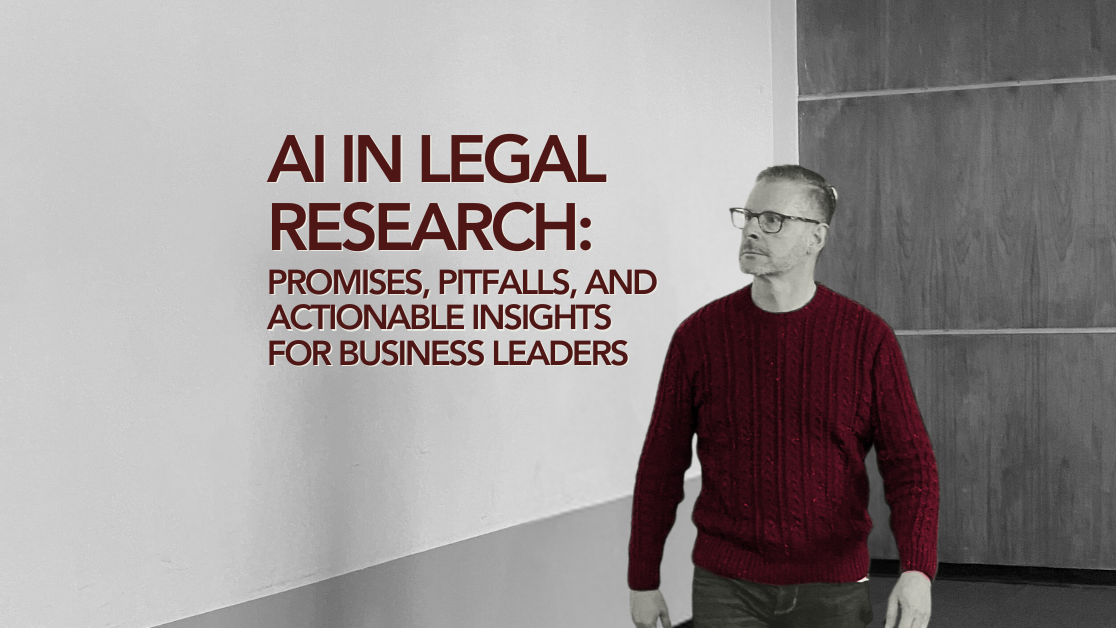AI in Legal Research: Promises, Pitfalls, and Actionable Insights for Business Leaders

In an era when artificial intelligence (AI) is revolutionizing industries, the legal sector is no exception. A recent comprehensive study from Stanford University has shed light on the performance of AI-driven legal research tools, revealing both their potential and limitations. For C-suite executives in middle-market organizations, understanding these findings is crucial for making informed decisions about AI adoption in legal processes.
A recent comprehensive study from Stanford University has shed light on the performance of AI-driven legal research tools, revealing both their potential and limitations. For C-suite executives in middle-market organizations, understanding these findings is crucial for making informed decisions about AI adoption in legal processes.
The State of AI in Legal Research as of July 2024
Researchers evaluated three major AI-powered legal research tools: LexisNexis’s Lexis+ AI, Thomson Reuters’s Ask Practical Law AI, and Westlaw’s AI-Assisted Research. These were compared against GPT-4, a general-purpose AI model. The study used a diverse set of over 200 legal queries to test these systems’ capabilities.
Key Findings
1. Hallucinations Persist
Despite claims of being “hallucination-free,” all tested AI tools produced false or misleading information at significant rates:
- Lexis+ AI: 18%
- Ask Practical Law AI: 17%
- Westlaw AI-Assisted Research: 33%
- GPT-4: 43%
2. Accuracy Varies
The tools showed different levels of accuracy in providing correct and relevant information:
- Lexis+ AI: 65%
- Ask Practical Law AI: 20%
- Westlaw AI-Assisted Research: 42%
- GPT-4: 49%
3. Responsiveness Differs
Some tools were more likely to provide complete answers than others, with Ask Practical Law AI giving incomplete answers 62% of the time.
4. Errors Occur with Complex Subject Matter
The AI tools sometimes made subtle but significant errors, such as misunderstanding case holdings, confusing arguments with rulings, or misapplying legal hierarchies.
Actionable Takeaways for Executives
Given AI’s lack of perfection, the following tips will help leaders mitigate the risks when using it to streamline legal research efforts.
- Approach AI Adoption Cautiously – While AI tools show promise in legal research, they are not yet reliable enough for unsupervised use. Implement these tools gradually, starting with low-stakes tasks.
- Establish Verification Protocols – Develop clear procedures for human verification of AI-generated legal research. This is crucial for maintaining accuracy and meeting ethical obligations.
- Invest in Training – Ensure your legal team is trained, not just in using these tools but in critically evaluating their outputs. This includes understanding common error types and how to spot them.
- Reassess Efficiency Gains – While AI promises increased efficiency, the need for thorough verification may offset some time savings. Conduct pilot programs to realistically assess the impact on productivity.
- Develop Clear Usage Policies – Establish guidelines for when and how AI tools should be used in legal research. This might include specifying types of cases or questions suitable for AI assistance.
- Prioritize Tool Selection – Given the performance variations among tools, carefully evaluate which AI system best fits your organization’s needs. Consider factors like accuracy, responsiveness, and the specific areas of law relevant to your business.
- Enhance Risk Management – Update your risk management strategies to account for potential errors from AI-driven legal research. This may include additional review layers for high-stakes matters.
- Foster a Culture of Critical Thinking – Encourage your legal team to maintain and sharpen their traditional research skills. AI should complement, not replace, human expertise.
- Stay Informed – The field of legal AI is rapidly evolving. Assign responsibility for staying updated on developments and regularly reassessing your AI strategy.
- Consider Ethical Implications – Be aware of the ethical considerations surrounding AI use in legal contexts. These include issues of transparency, bias, and maintaining attorney-client privilege.
- Communicate with Stakeholders – Develop a clear communication strategy about your use of AI in legal processes for clients, partners, and regulators. Transparency can help manage expectations and mitigate concerns.
- Explore Specialized Applications – Consider using AI tools for specific tasks where they excel, such as initial case research or document review, rather than for complex legal analysis.
The Bigger Picture
The integration of AI into legal processes represents a significant shift in how legal work is conducted. While these tools offer exciting possibilities for increased efficiency and broader access to legal information, they also present new challenges and risks.
For middle-market organizations, the key is to find a balance between leveraging the benefits of AI and managing its limitations. This requires a strategic approach that combines technological adoption with robust human oversight and critical thinking.
As AI evolves, these tools will likely become more accurate and reliable. However, for the foreseeable future, human expertise will remain crucial in legal decision-making processes. Organizations that can effectively blend AI capabilities with human insight will be best positioned to navigate the complex legal landscape of the future.
In conclusion, while AI in legal research is not yet the panacea some may have hoped for, it represents a powerful tool when used judiciously. By understanding its current limitations and implementing thoughtful strategies for its use, middle-market organizations can harness AI’s potential to enhance their legal capabilities while managing associated risks.
The path forward requires ongoing evaluation, adaptation, and a commitment to maintaining the highest standards of legal practice. As a C-suite executive, your role in guiding this integration is crucial. By staying informed, fostering a culture of responsible AI use, and maintaining a balance between innovation and caution, you can help your organization navigate the exciting but complex world of AI-assisted legal research.
Food for Thought
Navigating this rapidly evolving landscape can be challenging, especially when balancing the competing demands of your organization. This is where AI for the C Suite™ comes in. Our platform is designed to equip you with the knowledge, tools, and peer support necessary to lead confidently in the Exponential Age.
By joining AI for the C Suite™, you gain access to:
- Comprehensive educational resources, including our six-module AI Fundamentals course
- Insights on AI implementation and policy development
- A supportive community of fellow executives facing similar challenges
- Regular events featuring lessons learned in AI-driven transformation
- Custom applications and resources to simplify complex AI concepts
Don’t let the AI revolution pass you by. Take the next step in your AI leadership journey. Join AI for the C Suite™ today and position yourself and your organization at the forefront of this transformative technology. Together, we can harness the power of AI to drive innovation, efficiency, and growth in your organization.
This was not part of the list initially, but I think it should be. Let me know if incorrect.
